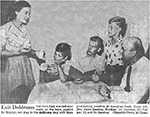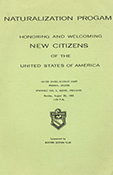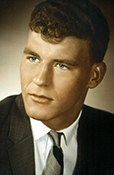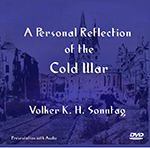|
|
|
Immigration Experience
This link will take you to my mother’s account of my family’s immigration, from our departure at Bremerhaven in late March of 1957, through our voyage across the Atlantic and subsequent train journey across the vast American landscape, to our arrival in Phoenix Arizona. Click here to read her account in German.
I spent my infancy and toddler years in a refugee camp called Lockstedter Lager, to which my mother fled in early 1945 with me and my older brother Gunther, who was six years old. My younger brother, Rüdiger was born in the camp in 1946.
This document is our official release from the refugee camp, and shows our refugee status.
Uprooted and unable to get a foothold in their postwar homes, many refugees began to consider a life where they might flourish beyond the boundaries of West Germany, even beyond Europe. Thrown back into hardship after my father fell ill in 1952, and spurred by information such as that provided in this brochure, my parents joined the flood of applicants.
Nearly ten years after World War II, in 1954, we found ourselves again classified as refugees. This link takes you to my mother’s identification papers. She was then forty years old.
My family was among the last boatloads of Eastern Europeans to immigrate to America under the Refugee Relief Act of 1953, which primarily aided expelled ethnic Germans and people who had fled East Germany at the end of the War. The Lutheran Immigration and Refugee Service collaborated in the resettlement of thousands of refugees. My family got in just under the wire; admissions ended the year we arrived. This photograph shows the former troop transporter that brought my family to America. Other photos of our immigration experience can be found in the photo gallery "Immigration Experience."
After arriving in New York and travelling to Chicago, my family boarded the famed Super Chief, star of the Atchison, Topeka, and Santa Fe Railway, for the final leg of our journey. We didn’t know it then, but the Super Chief dominated the Chicago-to-Los Angeles run and had reputedly been the the preferred mode of travel for Hollywood stars from the 1930s to the 1950s. This YouTube video will give you a sense of what it was like to travel onboard this magnificent train.
A month after our arrival in Phoenix, Arizona, my family made the news. This article in the Arizona Republic of June 1957 advertised our plight as recent immigrants but did nothing to provide leads to a job for my father.
It took four years for my parents to pay the Lutheran Refugee Service back for the loan given to them for our passage to America. Click here to see the Payment Notice and the Paid in Full receipt.
During a first trip back to Germany in 1965, while having dinner with my uncle and cousins, it became clear to me that I was an American. I began the naturalization process immediately upon my return, and became an American on August 29, 1966.
This video recounts my personal experience of the Cold War. I first gave this talk at a combined convention of American and German neurosurgeons in a renovated castle in Dresden in 2004. The reaction of my German colleagues inspired me to write my book, Backbone: A Journey from Refugee to Neurosurgeon.
|
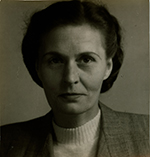

 Release from Lockstedter Lager Refugee Camp, 1948
Release from Lockstedter Lager Refugee Camp, 1948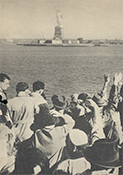
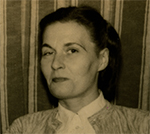

 SuperChief-Link to Video of Train Travel 1950s
SuperChief-Link to Video of Train Travel 1950s